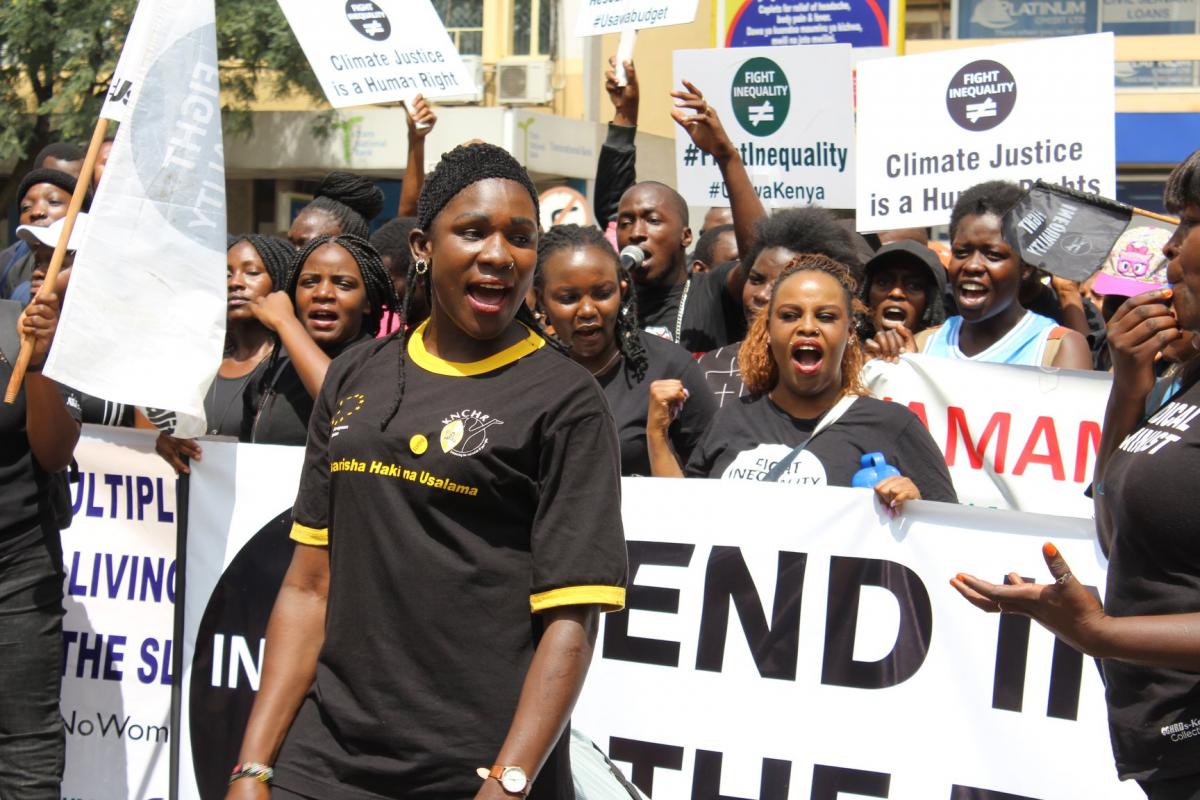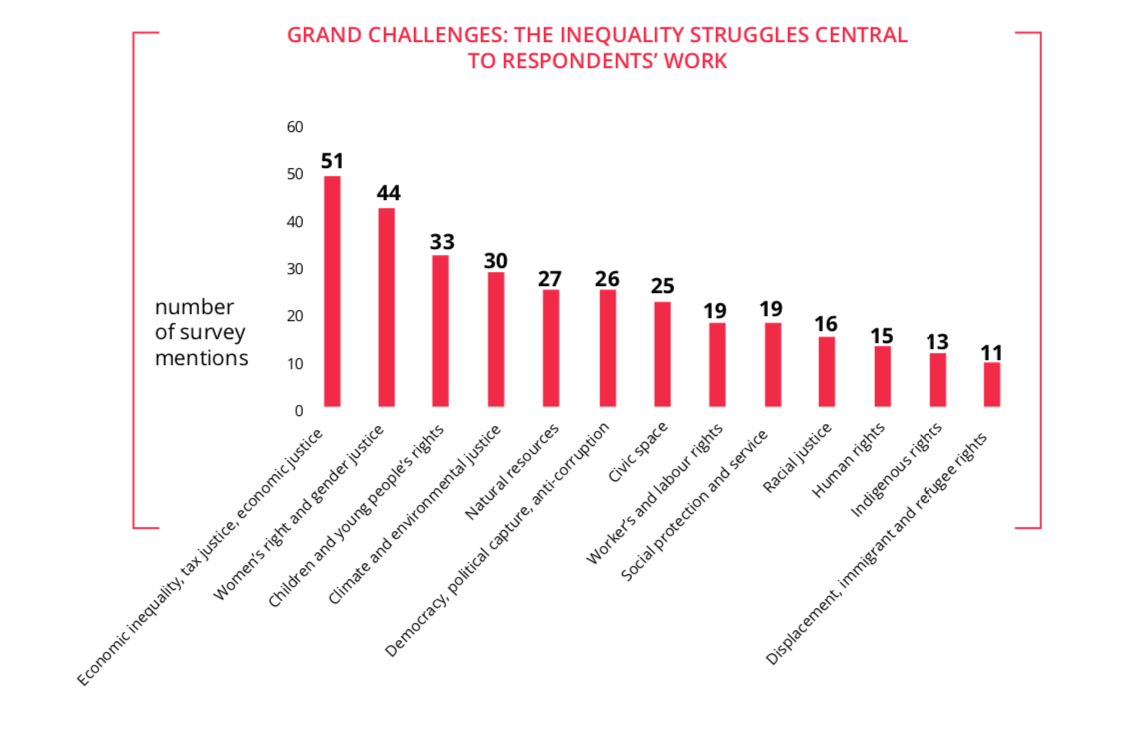By Allison Corkery and Ignacio Saiz

Last week, tens of thousands of people took to the streets as part of the Global Protest to #FightInequality. In more than 30 countries, people found collective and creative ways to say “Enough!” to elite greed. Marches, rallies, street theater, leaflet campaigns, art installations and murals, equality festivals, tax haven tours, music and film all featured. In 2019, mass mobilizations against socioeconomic injustices swept across the globe. Many are still ongoing. The Global Protest—spearheaded by the Fight Inequality Alliance—channeled this energy.
Now in its third year, the Global Protest coincides with the World Economic Forum, which takes place annually in Davos, a Swiss ski resort. Calling out the hypocrisy of this global elite talkfest may be an easy target. But the Protest’s broader message is a critical one: real change to the system that perpetuates inequality will come from radical people-powered solutions.
Leading human rights figures are increasingly acknowledging the threat posed by inequality. But, for the most part, there’s still a lot of uncertainty about whether and how human rights strategies and tactics can help amplify the kind of people power the Global Protest calls for. A new report published by the Fight Inequality Alliance at the end of last year sheds light on that question.
There is a plethora of research on inequality that analyzes its symptoms and causes. But very little examines activism against it. To fill this gap, researchers gathered 170 survey responses and conducted 40 in-depth interviews with inequality activists around the world.
The report offers rich food for thought for a human rights NGO like CESR that has made tackling socioeconomic inequality its central focus. It prompts us to think more creatively about how human rights tools and approaches might better support the struggles of those directly affected by inequality. Three closely related findings jump out in particular.

First, as shown in the graph, few activists surveyed (15%) are framing their struggles in human rights terms. Women’s rights and children’s rights feature prominently. But, overall, activists don’t appear to be making (or at least foregrounding) the link between human rights and their priority issues, such as economic justice, climate action, natural resource governance, and anti-corruption.
This isn’t a huge surprise. Activists tend to be more familiar with protections for civil and political rights—and what they obligate governments to do—than for socioeconomic rights. But, as collaborative research with South African activists illustrates, human rights becomes a less effective framing tool as a result.
This motivates us to unpack the ways that expanding “literacy” on socioeconomic rights can support social movements to contest power. Awareness of rights obligations helps activists shift the narrative about what is just and unjust about our economic system. By demanding that certain material conditions are so essential for human flourishing that they must be guaranteed to all, socioeconomic rights protections directly challenge the logic of neoliberalism.
Second, the report offers critical insights on navigating power dynamics within and across movements. Most movements surveyed emerged locally, in response to people’s direct experiences of injustice. But others are global and seek broad-based change. It’s hard to meaningfully connect “bottom up” strategies with strategies targeting those “at the top.” Ideas about "who has expertise and who can influence” end up undermining grassroots leadership—particularly women’s.
This challenge is a familiar one to international human rights advocates, who tend to target the top. It was also the focus of a study on the anti-corruption movement published by the Carnegie Endowment this month. As the study notes, the gap means that grassroots networks struggle “to turn protest energy into targeted demands and lasting reform,” while technocratic NGOs “lack the people power” to advance their policy recommendations.
This reminds us that working collaboratively across movements and sites of struggle—in a way that has genuine mutual benefits—takes more than good will. It’s important to identify the barriers to “pooling different kinds of power,” as the report puts it, and recognize how much labor goes into designing and implementing specific strategies for overcoming them. To do this, more spaces for honest reflection and action planning on what it takes to build and sustain connections are important.
Third, the report finds a notable appetite for connections that help activists learn from each other’s strategies and tools. Half of all survey respondents listed “collaboration on research and analysis” and “training in specific skills and approaches” among the top three types of support that would make a difference to their cause. This was a surprise to see. Research tends to be seen as technical and “wonky,” disconnected from the political work of mobilizing communities. But, as the report points out, often activists are trying to address implicit power structures. This means the “enemy” or “target” is not obvious. How their actions result in widening inequality is opaque. Research helps uncover this.
This encourages us to continue experimenting with new ways to support activists in analyzing the structural causes common across different inequality struggles. Applying a human rights approach to research on inequality means valuing the expertise and leadership of communities most affected by it. It means co-designing tools that facilitate “inside out” analysis of their experience, to bring to the surface how the concentration of political and economic power enables rights violations and fuels inequality.
At CESR, we’re leveraging human rights to contribute to the fight against inequality in various ways. Our interdisciplinary research with partners in Peru, Colombia, Brazil, Egypt and South Africa offers a new perspective on how unjust fiscal policies fuel inequality and deprive people of rights. Our advocacy seeks to shift rhetoric and practice so that international human rights standards are deployed to bring about more redistributive economic policies. We seek to build solidarity between movements working for equality through the exchange of skills, knowledge, and learning.
Many allies in the fight against inequality are still working out what different forms of solidarity look like in practice. This is likely to continue to evolve, as the report notes. And it’s certainly the case for us at CESR. As we design our next organizational strategy, in particular, we are listening to and learning from our partners and allies, who would like to see our work on inequality deepen. We’re energized to pursue “deeper organizing and greater collaboration” with an ever-wider range of inequality activists. It’s only through bold progressive alliances that we can revert the regressive trends of our time.
Image of protestors in Kenya and report graphic courtesy of the Fight Inequality Alliance.
Related: